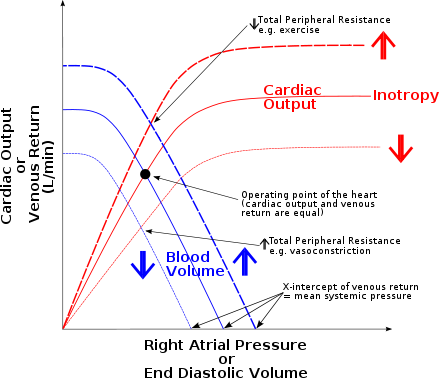Cardiac function curve
Acardiac function curveis a graph showing the relationship betweenright atrial pressure(x-axis) andcardiac output(y-axis).[citation needed]Superimposition of the cardiac function curve andvenous return curveis used in onehemodynamicmodel.[1]
Shape of curve
[edit]


It shows a steep relationship at relatively low filling pressures and a plateau, where further stretch is not possible and so increases in pressure have little effect on output. The pressures where there is a steep relationship lie within the normal range of right atrial pressure (RAP) found in the healthy human during life. This range is about -1 to +2mmHg.The higher pressures normally occur only indisease,in conditions such asheart failure,where the heart is unable to pump forward all the blood returning to it and so the pressure builds up in the right atrium and the great veins. Swollen neck veins are often an indicator of this type of heart failure.[citation needed]
At low right atrial pressures this graph serves as a graphic demonstration of theFrank–Starling mechanism,[2]that is as more blood is returned to the heart, more blood is pumped from it without extrinsic signals.
Changes in the cardiac function curve
[edit]In vivohowever, extrinsic factors such as an increase in activity of thesympathetic nerves,and a decrease invagal tonecause the heart to beat more frequently and more forcefully. This alters the cardiac function curve, shifting it upwards. This allows the heart to cope with the required cardiac output at a relatively low right atrial pressure. We get what is known as a family of cardiac function curves, as the heart rate increases before the plateau is reached, and without the RAP having to rise dramatically to stretch the heart more and get the Starling effect.[citation needed]
In vivosympatheticoutflowwithin themyocardiumis probably best described by the time honored description of thesinoatrialtree branching out toPurkinges fibers.Parasympatheticinflowwithin the myocardium is probably best described by influence of thevagus nerveandspinal accessory ganglia.[citation needed]
See also
[edit]References
[edit]- ^Brengelmann GL (March 2003)."A critical analysis of the view that right atrial pressure determines venous return".J. Appl. Physiol.94(3): 849–59.doi:10.1152/japplphysiol.00868.2002.PMID12391065.
- ^"Cardiac Basic Physiology".Archived fromthe originalon 2008-10-11.
